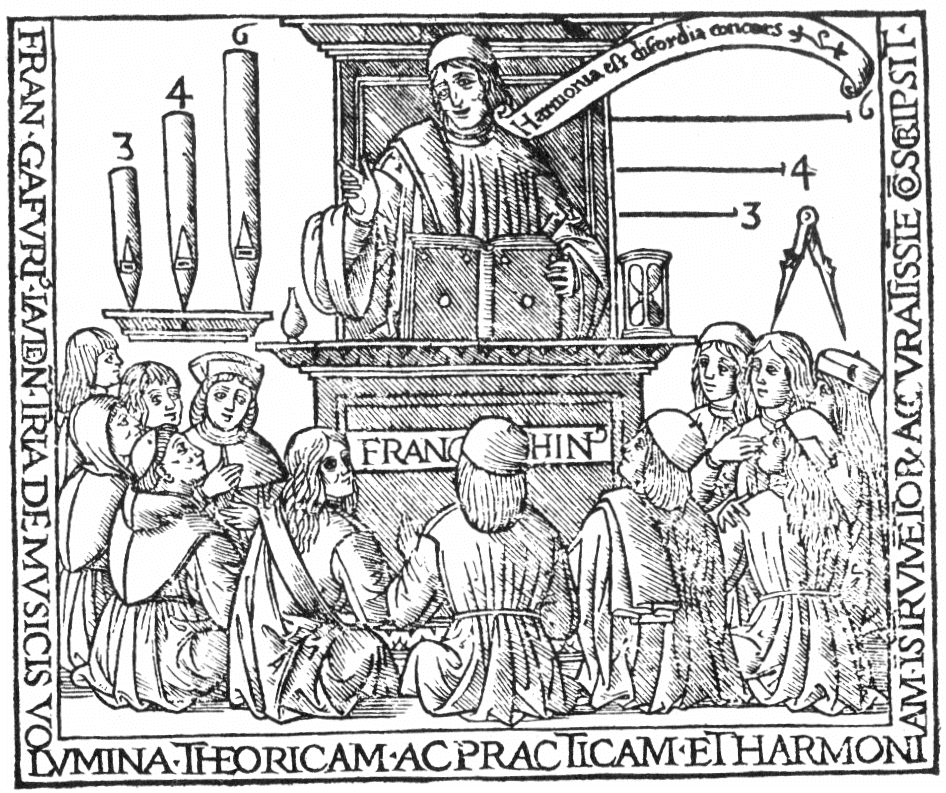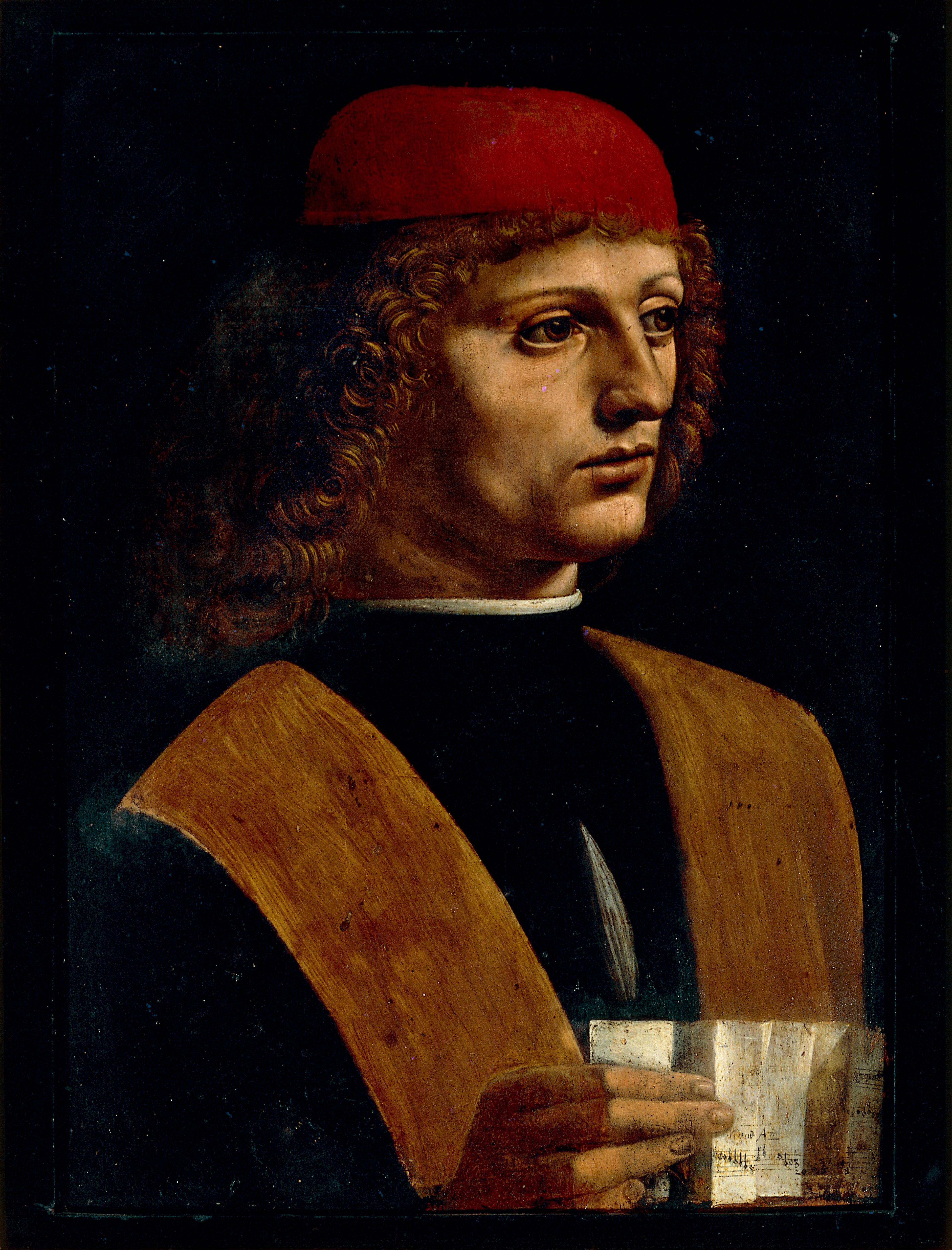Franchino Gaffurio on:
[Wikipedia]
[Google]
[Amazon]

 Franchinus Gaffurius (Franchino Gaffurio; 14 January 1451 – 25 June 1522) was an Italian
Franchinus Gaffurius (Franchino Gaffurio; 14 January 1451 – 25 June 1522) was an Italian
 During the previous decade the
During the previous decade the
 Gaffurius wrote
Gaffurius wrote

 Franchinus Gaffurius (Franchino Gaffurio; 14 January 1451 – 25 June 1522) was an Italian
Franchinus Gaffurius (Franchino Gaffurio; 14 January 1451 – 25 June 1522) was an Italian music theorist
Music theory is the study of theoretical frameworks for understanding the practices and possibilities of music. '' The Oxford Companion to Music'' describes three interrelated uses of the term "music theory": The first is the " rudiments", that ...
and composer of the Renaissance.
Life
He was born in Lodi to an aristocratic family. Early in life he entered aBenedictine
The Benedictines, officially the Order of Saint Benedict (, abbreviated as O.S.B. or OSB), are a mainly contemplative monastic order of the Catholic Church for men and for women who follow the Rule of Saint Benedict. Initiated in 529, th ...
monastery, where he acquired his early musical training; later he became a priest
A priest is a religious leader authorized to perform the sacred rituals of a religion, especially as a mediatory agent between humans and one or more deity, deities. They also have the authority or power to administer religious rites; in parti ...
. Later he lived in Mantua
Mantua ( ; ; Lombard language, Lombard and ) is a ''comune'' (municipality) in the Italian region of Lombardy, and capital of the Province of Mantua, eponymous province.
In 2016, Mantua was designated as the "Italian Capital of Culture". In 2 ...
and Verona
Verona ( ; ; or ) is a city on the Adige, River Adige in Veneto, Italy, with 255,131 inhabitants. It is one of the seven provincial capitals of the region, and is the largest city Comune, municipality in the region and in Northeast Italy, nor ...
before settling in Milan
Milan ( , , ; ) is a city in northern Italy, regional capital of Lombardy, the largest city in Italy by urban area and the List of cities in Italy, second-most-populous city proper in Italy after Rome. The city proper has a population of nea ...
as the ''maestro di cappella
( , , ), from German (chapel) and (master), literally "master of the chapel choir", designates the leader of an ensemble of musicians. Originally used to refer to somebody in charge of music in a chapel, the term has evolved considerably in i ...
'' at the cathedral there, a position which he accepted in January 1484.
 During the previous decade the
During the previous decade the Sforza
The House of Sforza () was a ruling family of Renaissance Italy, based in Milan. Sforza rule began with the family's acquisition of the Duchy of Milan following the extinction of the Visconti of Milan, Visconti family in the mid-15th century and ...
family, using the composer Gaspar van Weerbeke
Gaspar van Weerbeke ( – after 1516) was a Netherlandish composer of the Renaissance. He was of the same generation as Josquin des Prez, but unique in his blending of the contemporary Italian style with the older Burgundian style of Dufay.
L ...
as a recruiter, had built the choir at their chapel in Milan into one of the largest and most distinguished musical ensembles in Europe: composer-singers such as Alexander Agricola
Alexander Agricola (; born Alexander Ackerman; – 15 August 1506) was a Netherlandish composer of the Renaissance writing in the Franco-Flemish style. A prominent member of the ''Grande chapelle'', the Habsburg musical establishment, he was ...
, Loyset Compère
Loyset Compère ( – 16 August 1518) was a Franco-Flemish composer of the Renaissance. Of the same generation as Josquin des Prez, he was one of the most significant composers of motets and chansons of that era, and one of the first musicia ...
and Johannes Martini
Johannes Martini (c. 1440 – late 1497 or early 1498) was a Franco-Flemish composer of the Renaissance.
Life
He was born in Brabant around 1440, but information about his early life is scanty. He probably received his early training in F ...
had all been employed there. While the membership of the choir at the Milan cathedral was mostly Italian, the cross-influence between his choir and the group at the Sforza chapel was significant. Gaffurius retained the post at the cathedral for the rest of his life, and it was in Milan that he knew both Josquin des Prez and Leonardo da Vinci.
Writings
Gaffurius was widely read, and showed a strong Renaissance humanist bent. In addition to having a thorough understanding of contemporary musical practice, he met composers from all over Europe, since he had the good fortune to be living and working at one of the centers of activity for the incoming Netherlanders. His books have a pedagogical intent, and provide a young composer with all the techniques necessary to learn his art. The major treatises of his years in Milan are three: ''Theorica musicae'' (1492), ''Practica musicae'' (1496), and ''De harmonia musicorum instrumentorum opus'' (1518). The second of these, the ''Practica musicae'', is the most thorough, proceeding through subjects as diverse as ancient Greek notation,plainchant
Plainsong or plainchant (calque from the French ; ) is a body of chants used in the liturgies of the Western Church. When referring to the term plainsong, it is those sacred pieces that are composed in Latin text. Plainsong was the exclusive for ...
, mensuration, counterpoint
In music theory, counterpoint is the relationship of two or more simultaneous musical lines (also called voices) that are harmonically dependent on each other, yet independent in rhythm and melodic contour. The term originates from the Latin ...
, and tempo
In musical terminology, tempo (Italian for 'time'; plural 'tempos', or from the Italian plural), measured in beats per minute, is the speed or pace of a given musical composition, composition, and is often also an indication of the composition ...
. One of his most famous comments is that the ''tactus'', the tempo of a semibreve
A whole note (American) or semibreve (British) in musical notation is a single note equivalent to or lasting as long as two half notes or four quarter notes. Description
The whole note or semibreve has a note head in the shape of a hollow o ...
, is equal to the pulse of a man who is breathing quietly—presumably about 72 beats per minute.
Music
mass
Mass is an Intrinsic and extrinsic properties, intrinsic property of a physical body, body. It was traditionally believed to be related to the physical quantity, quantity of matter in a body, until the discovery of the atom and particle physi ...
es, motet
In Western classical music, a motet is mainly a vocal musical composition, of highly diverse form and style, from high medieval music to the present. The motet was one of the preeminent polyphonic forms of Renaissance music. According to the Eng ...
s, settings of the Magnificat
The Magnificat (Latin for "y soulmagnifies he Lord) is a canticle, also known as the Song of Mary or Canticle of Mary, and in the Byzantine Rite as the Ode of the Theotokos (). Its Western name derives from the incipit of its Latin text. This ...
, and hymn
A hymn is a type of song, and partially synonymous with devotional song, specifically written for the purpose of adoration or prayer, and typically addressed to a deity or deities, or to a prominent figure or personification. The word ''hymn'' d ...
s, mainly during his Milan years. Some of the motets were written for ceremonial occasions for his ducal employer; many of the masses show the influence of Josquin, and all are in flowing Netherlandish polyphony
Polyphony ( ) is a type of musical texture consisting of two or more simultaneous lines of independent melody, as opposed to a musical texture with just one voice ( monophony) or a texture with one dominant melodic voice accompanied by chord ...
, though with an admixture of Italian lightness and melody. His music was collected in four codices under his own direction.
Selected recordings
* Franchino Gaffurio ''Missa de Carneval'' Motets:Stabat Mater
The Stabat Mater is a 13th-century Christian hymn to the Virgin Mary that portrays her suffering as mother during the crucifixion of her son Jesus Christ. Its author may be either the Franciscan friar Jacopone da Todi or Pope Innocent III.Saba ...
, Adoramus Te, Imperatrix reginarum, Imperatrix gloriosa, Florem ergo, Res miranda, Salve Regina
The "Salve Regina" ( , ; meaning "Hail Queen"), also known as the "Hail Holy Queen", is a Marian hymn and one of four Marian antiphons sung at different seasons within the Christian liturgical calendar of the Catholic Church. The Salve Regina ...
, Lamentatio, Magnificat, O sacrum convivium, Quando venit, Ave corpus. Il Convitto Armonico, Baschenis Ensemble, Stefano Buschini. Tactus 2012
References
* Articles "Franchinus Gaffurius," "Leonardo da Vinci" in ''The New Grove Dictionary of Music and Musicians'', ed. Stanley Sadie. 20 vol. London, Macmillan Publishers Ltd., 1980. * * *Gustave Reese
Gustave Reese ( ; November 29, 1899 – September 7, 1977) was an American musicologist and teacher. Reese is known mainly for his work on medieval and Renaissance music, particularly with his two publications ''Music in the Middle Ages'' (1940 ...
, ''Music in the Renaissance''. New York, W.W. Norton & Co., 1954.
External links
* * {{DEFAULTSORT:Gaffurius, Franchinus Italian Renaissance composers Italian male classical composers Italian music theorists Italian Renaissance humanists 1451 births 1522 deaths People from Lodi, Lombardy Italian Benedictines